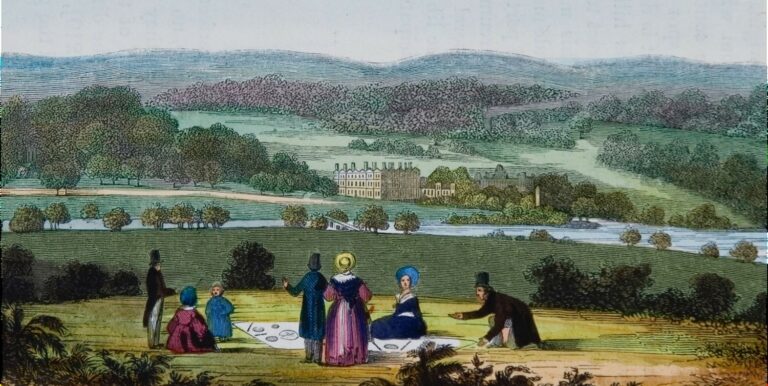Edward has come to visit, and following a local walk he declares that he has seen pleasing prospects and views across the valley. Marianne, an ardent and vocal admirer of landscape, begins to question him minutely about the objects which had particularly struck him when he interrupts her, saying, “You must not enquire too far, Marianne – remember I have no knowledge in the picturesque, and I shall offend you by my ignorance and want of taste if we come to particulars. I shall call hills steep, which ought to be irregular and rugged, and distant objects out of sight, which ought only to be indistinct through the soft medium of a hazy atmosphere.”
The irony here is that, whilst professing to know nothing of the Picturesque, Edward shows a very good knowledge of some of its key characteristics. Rugged landscape, irregular lines, and a painterly haze are all qualities of the eighteenth century Picturesque aesthetic.
Edward then describes what he sees as the benefits of the landscape – plenty of timber in the woods, neat farmhouses, a ‘comfortable’ valley and rich meadows. He judges it a fine country “because it unites beauty with utility”, and goes on to say, “I dare say it is a picturesque one too, because you admire it; I can easily believe it to be full of rocks and promontories, grey moss and brush wood, but these are all lost on me. I know nothing of the picturesque.”
Once again, his professed ignorance betrays a knowledge of common Picturesque components – rocky, mossy outcrops and steep drops – together with blasted twisty trees clinging perilously to hillsides, which he mentions later. We need only add deep ravines, gushing water and a general wildness, to cover all the main elements. This is the type of landscape admired by the emotional, romantic Marianne, but not by the sensible, practical Edward. Marianne is baffled by Edward’s failure to embrace the Picturesque, responding to his professed ignorance of Picturesque principles with, “I am afraid it is but too true …. But why should you boast of it?”.
Edward concludes the conversation by asserting that, whilst he is convinced that Marianne truly feels all the delight in landscape that she professes to feel, nonetheless begs that she allow him to – “feel no more than I profess. I like a fine prospect, but not on picturesque principles. I do not like crooked, twisted, blasted trees. I admire them much more if they are tall, straight and flourishing. I do not like ruined, tattered cottages. I am not fond of nettles or thistles, or heath blossoms…”
“Marianne looked with amazement at Edward”.
Jane Austen’s own detailed knowledge of the Picturesque, together with her masterly creation of character and dialogue here, beautifully encapsulates both the Picturesque itself and the associated ‘feelings’ which underpin its aesthetic.





